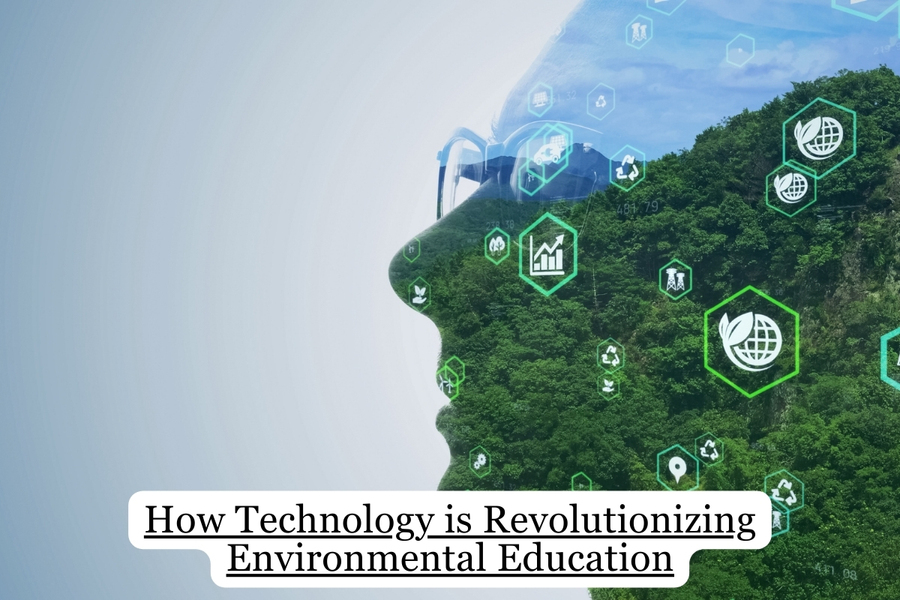

Environmental education is essential in forming the future of our world at a time when environmental concerns are only increasing. The rapid development of technology has changed the way we learn about sustainability and environmental concerns.
By providing creative ideas to include students in more engaging, accessible, and practical ways, technology is removing obstacles to education. This paper investigates the major influence technology has on teachers as well as students and how it is transforming environmental education.
Modern education has been significantly shaped by technology, which has also changed how knowledge is presented, accessed, and comprehended. Digital technologies’ incorporation into the classroom has many advantages, including boosting accessibility, increasing interest in learning, and supporting individualized learning experiences.
These advantages are especially apparent in environmental education as technology enables more accessible, hands-on presentation of complicated environmental ideas. Real-time data interaction, environmental change visualization, and access to worldwide resources are all changing how students see and address environmental problems.
Many digital tools and venues provided by technology have significantly improved environmental education. Virtual field excursions, for instance, let students investigate ecosystems from all across the world without actually stepping outside the classroom. Platforms such as Google Earth allow students to virtually explore rainforests, coral reefs, or endangered species habitats, giving them a more thorough understanding of the environmental difficulties these ecosystems confront.
Educational platforms and online courses also play a significant role in environmental education. Websites such as Coursera, EdX, and YouTube offer accessible resources for learners to study environmental topics at their pace.
In a world where time and location often present challenges to education, these platforms serve as a bridge, enabling students to engage with environmental education from any location.
For students looking to dive deeper into environmental topics, technology can offer an additional support system. If you’re overwhelmed with coursework or just need some extra help on a project, don’t hesitate to seek professional help. A quick search for “write my essay” can connect you to services that can guide you through complex environmental studies, ensuring that your learning process remains smooth and productive.
The use of real-time data and analytics is among the most transforming features of technology in environmental education. Tools that gather environmental data—such as air quality monitors, temperature monitoring stations, and satellite photos—give students current knowledge of the environmental state. This information helps students to monitor changes over time and study patterns, enabling them to grasp the pressing character of problems such as pollution, deforestation, and climate change.
Online portals and interactive dashboards provide a practical approach to investigate this information. For instance, NOAA’s climate data portal offers students graphic representations of climate information, therefore enabling them to study the consequences of environmental changes all over.
Technology has also helped citizen science initiatives to become more popular since it lets people all across the globe contribute to environmental research. Projects such as iNaturalist let students track and record biodiversity, therefore supporting scientific initiatives even as they acquire knowledge.
Another powerful weapon for transforming environmental education is gamification. Gamification boosts involvement and motivation by turning learning into a game. Games let students engage with environmental ideas in enjoyable and dynamic ways. Simulation games, for instance, enable players to construct sustainable communities, control natural resources, or test eco-friendly techniques.
Games emphasizing conservation, sustainability, and the environment help children understand the fragile balance needed to preserve natural equilibrium. Students acquire critical thinking and problem-solving abilities they may use in their actual lives by means of virtual environments addressing practical issues. Gamification therefore provides an intriguing means to teach while maintaining student involvement.
Social media channels are becoming essential instruments for disseminating environmental awareness. These channels let companies and people disseminate knowledge about sustainable practices and environmental concerns. Social media may be utilized by teachers, environmental campaigners, and universities to build communities dedicated to information sharing and planet advocacy.
Online communities on sites like Instagram, Twitter, and Facebook provide students a forum to talk about environmental issues, exchange ideas, and even organize group action. Younger generations, who are more active on social media, are also more affected by it. By means of these internet networks, environmental education reaches a larger audience, hence motivating worldwide action on sustainability and climate change.
Many technical developments are being driven by artificial intelligence (AI) and machine learning; environmental education is no exception. Artificial intelligence is being used to examine significant environmental change-related data sets, forecast climate trends, and provide more precise models of environmental systems. These tools help students to grasp the science behind climate forecasts and enable them to make educated choices depending on this knowledge.
Providing individualized learning experiences also involves machine learning technologies. These technologies may provide customized suggestions by means of data analysis on student performance, guiding students’ attention to the areas most requiring their attention. Starting to help with inquiries on difficult environmental issues, AI-driven systems are making education more engaging and accessible.
The future of technology in environmental education offers intriguing opportunities. Emerging technologies, such as Virtual Reality (VR) and Augmented Reality (AR), will probably provide even more engaging methods to educate about the environment. Imagine digitally strolling through the Amazon jungle, experiencing firsthand the effects of deforestation, or exploring the ocean depths to discover marine conservation initiatives.
Artificial intelligence and machine learning will increasingly influence the creation of more tailored and efficient learning environments. Using these technologies, students may simulate environmental situations to acquire problem-solving and decision-making abilities by interacting with real-time data and models. By building a worldwide, interconnected environmental education system with technology, students can gain a deeper and more engaging understanding of the world’s most pressing issues.
There is no question that environmental education is being transformed by technology. It allows students to grasp the complexity of our world and the need for sustainability by making learning more accessible, interesting, and participatory.
The options for environmental education are limitless as technology develops; with ongoing creativity, we may want to motivate future generations to participate in protecting our world for many years to come.
